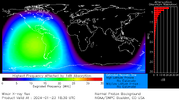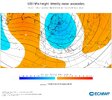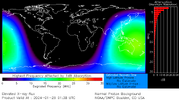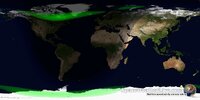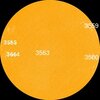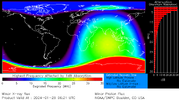SOLAR CYCLE 25 ACTIVITY REPORT JANUARY 24_2024
M-class flares from AR3561

● M2.44 at 08:11 UTC the flare caused a Minor R1 radio blackout over Indian Ocean
● M2.39 at 08:22 UTC the flare caused a Minor R1 radio blackout over Indian Ocean

● M1.02 at 13:08 UTC the flare caused a Minor R1 radio blackout over South Atlantic Ocean
● M1.01 at 14:38 UTC the flare caused a Minor R1 radio blackout over South Atlantic Ocean
● M1.3 at 14:59 UTC the flare caused a Minor R1 radio blackout over South Atlantic Ocean

● M4.3 at 16:40 UTC the flare caused a Minor R1 radio blackout over South America

● M1.0 at 18:28 UTC the flare caused a Minor R1 radio blackout over Southwest Pacific Ocean
● M1.1 at 18;44 UTC the flare caused a Minor R1 radio blackout over Southwest Pacific Ocean
● M1.0 at 19:52 UTC the flare caused a Minor R1 radio blackout over Southwest Pacific Ocean
● M1.0 at 20:01 UTC the flare caused a Minor R1 radio blackout over Southwest Pacific Ocean


Aurora Oval Bz: -1.75 nT South

● Current Conditions at 05:25 UTC on January 24
▪︎ Geospace active (Kp 4) threshold reached at 02:44 UTC
▪Solar wind speed record: 455 km/sec (Elevated speed)
▪︎ density: 5.02 p/cm³ (low density)
▪︎ Interplanetary Magnetic Field (IMF)
Bt: 3.97 nT
▪︎ X-ray Solar Flare: M2 0141 UT Jan24 from AR3561 the flare caused a Minor R1 radio blackout over South east Asia

▪︎ Thermosphere Climate Index
today: 19.66x1010 W Warm
▪︎ Neutron Counts today: -4.8 % (Low)
▪︎ Sunspot number: 123 (SN 139 January 23)
▪︎ Spotless Days 2023 total: 0 days (0%)
▪︎There are no significant coronal holes on the Earthside of the sun
..........
SpaceWeatherlive.com
SpaceWeather.com
Solar activity has been at high levels for the past 24 hours. AR3561 has produced 10 M-class solar flares, however the largest solar event of the period was a M5 event observed at 0331 UTC from AR3559 (see previous report)
M-class flares from AR3561
● M2.44 at 08:11 UTC the flare caused a Minor R1 radio blackout over Indian Ocean
● M2.39 at 08:22 UTC the flare caused a Minor R1 radio blackout over Indian Ocean
● M1.02 at 13:08 UTC the flare caused a Minor R1 radio blackout over South Atlantic Ocean
● M1.01 at 14:38 UTC the flare caused a Minor R1 radio blackout over South Atlantic Ocean
● M1.3 at 14:59 UTC the flare caused a Minor R1 radio blackout over South Atlantic Ocean
● M4.3 at 16:40 UTC the flare caused a Minor R1 radio blackout over South America
● M1.0 at 18:28 UTC the flare caused a Minor R1 radio blackout over Southwest Pacific Ocean
● M1.1 at 18;44 UTC the flare caused a Minor R1 radio blackout over Southwest Pacific Ocean
● M1.0 at 19:52 UTC the flare caused a Minor R1 radio blackout over Southwest Pacific Ocean
● M1.0 at 20:01 UTC the flare caused a Minor R1 radio blackout over Southwest Pacific Ocean
HYPERACTIVE SUNSPOT: The sun is crackling with solar flares, and almost all of them are coming from hyperactive sunspot AR3561. There have been more than a dozen M-class eruptions in the past day and a half:
The profusion of flares since the late hours of Jan. 22nd directly tracks the rapid growth of AR3561, which didn't exist when the week began. It is now a sprawling sunspot group 100,000 km wide with more than 20 dark cores. It has a mixed-polarity magnetic field that makes it naturally prone to frequent eruptions.
NOAA forecasters estimate a 75% chance of more M-class flares on Jan. 24th. Make that 100%. We've already observed two. How many will there be when the day is over? Stay tuned. SpaceWeather.com
MASSIVE SOLAR BLAST: If you look carefully (use full screen) at the SDO 304A image (orange) you see a filament erupt in the SW. It propagates through the LASCO inner field (red) and then through the outer field (blue). I estimate that the CME would contain over 100 million Earths
There are currently 08 sunspot regions on the solar disk: AR3549, AR3553 AR3555, AR3556, AR3559, AR3560, AR3561 & AR3562Total number of sunspots has decreased to 123 (54 of these are grouped into 8 active regions) NOAA forecasts for the next 24h: 99% chance for C flares, 75% chance M flares and 10% chance for X flares.
AR3559 & AR361 have a beta-gamma magnetic field that harbors energy for M-class flares
● Auroral Activity
The geomagnetic field has been at quiet (Kp1) to active levels (Kp4) for the past 24 hours. On January 23 Solar wind speed reached a peak of 444 km/s (Elevated speed) at 22:37 UTC. Total IMF reached 12 nT at 21:05 UTC (Strong impact to Earth's magnetic field)
AR3559 & AR361 have a beta-gamma magnetic field that harbors energy for M-class flares
● Auroral Activity
The geomagnetic field has been at quiet (Kp1) to active levels (Kp4) for the past 24 hours. On January 23 Solar wind speed reached a peak of 444 km/s (Elevated speed) at 22:37 UTC. Total IMF reached 12 nT at 21:05 UTC (Strong impact to Earth's magnetic field)
GEOMAGNETIC STORM WATCH (G1): NOAA forecasters say there is a chance of minor G1-class geomagnetic storms for the next 3 days. This is in response to multiple CMEs expelled by the sun, some of them approximately aimed at Earth. Glancing blows could disturb our planet's magnetic field on Jan. 24th, 25th and 26th. SpaceWeather.com
Aurora Oval Bz: -1.75 nT South
● Current Conditions at 05:25 UTC on January 24
▪︎ Geospace active (Kp 4) threshold reached at 02:44 UTC
▪Solar wind speed record: 455 km/sec (Elevated speed)
▪︎ density: 5.02 p/cm³ (low density)
▪︎ Interplanetary Magnetic Field (IMF)
Bt: 3.97 nT
▪︎ X-ray Solar Flare: M2 0141 UT Jan24 from AR3561 the flare caused a Minor R1 radio blackout over South east Asia
▪︎ Thermosphere Climate Index
today: 19.66x1010 W Warm
▪︎ Neutron Counts today: -4.8 % (Low)
▪︎ Sunspot number: 123 (SN 139 January 23)
▪︎ Spotless Days 2023 total: 0 days (0%)
▪︎There are no significant coronal holes on the Earthside of the sun
..........
SpaceWeatherlive.com
SpaceWeather.com


